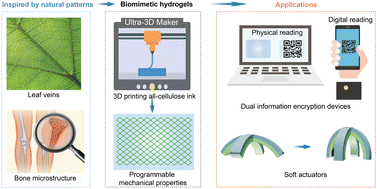An information encrypted heterogeneous hydrogel with programmable mechanical properties enabled by 3D patterning†
Abstract
Heterogeneous architectures with defined patterns found in nature have stimulated the burgeoning development of biomimetic materials. However, the construction of soft matter like hydrogels that mimic biological materials with a combination of strong mechanical performance and unique functionality remains difficult. In this work, we developed a simple and adaptable strategy of a 3D printing complex structure within hydrogels utilising all-cellulosic materials (hydroxypropyl cellulose/cellulose nanofibril, HPC/CNF) as ink. The structural integrity of the patterned hydrogel hybrid is ascertained by the interfacial interaction between cellulosic ink and the surrounding hydrogels. Through designing the geometry of the 3D printed pattern, programmable mechanical properties of hydrogels are achieved. In addition, the thermally induced phase separation properties of HPC confer thermally responsive behaviour on patterned hydrogels, providing them potential to be assembled into double information encryption devices and shape-morphing materials. We anticipate that this all-cellulose ink-enabled 3D patterning technique within hydrogels can serve as a promising and sustainable alternative for designing biomimetic hydrogels with desired mechanical properties and functions for a variety of applications.

- This article is part of the themed collection: Materials Horizons 10th anniversary regional spotlight collection: The Americas


 Please wait while we load your content...
Please wait while we load your content...